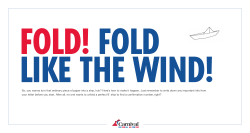
How to Make a Hexagonal (6-Sided) Snowflake
How to Make a Hexagonal (6-Sided) Snowflake You need: paper, scissors, pencil (optional), and a trash or recycle container! 1 Fold up the corner of a rectangular sheet of paper diagonally so the side edges match up. Printer paper works fine, but thinner paper such as rice paper can be easier to cut. 2 Cut off the extra rectangle. Make your cuts over a table or desk so that it is easy to wipe the small pieces into a trash or recycle container. 3 Now what remains is a square folded in half diagonally. To make it hexagonal, it will have to be folded so that the corners can be cut off and 6 sides created. 4 Turn the paper so that the fold is at the top. 5 Fold the left corner over to meet the right corner and carefully crease just the top of the fold. Do not crease the entire fold! 6 Unfold the triangle. You should now see the crease at the top, mid-way between the two corners. 7 Take one of the top corners and fold it over (do not crease yet) only as far as the crease at the top. 8 Fold over the other corner in the same way. Do not crease yet. The two folded flaps need to be adjusted now so that they meet at a point at the top where the crease is, and so they are both the same size – all the edges match up on the left and right sides. 9 Once step 8 is achieved, then you crease the folds of the two flaps. 10 Turn the paper so that the crease is at the bottom and the shape points to the left. 11 Fold the shape in half by folding the bottom seam edge up to the top edge. 12 Crease the new seam. 13 Your paper should look like this now. For the purposes of this explanation, position the seam at the bottom. 14 Now cut off the “ears” as shown. 15 This cuts off the four corners of the square. Since the paper is folded into sixths (12ths, actually), it also creates the six sections. Now you are ready to start cutting the snowflake design. For intricate designs, it can be helpful to sketch the design on one side of the paper very lightly with pencil. Shade the parts to be cut out. 16 Anything cut out of the point is really being cut from the center of the snowflake. 17 A design cut along the top edge (the open side) will be along the outer edges of the 6 “spokes”. Caution: Do not cut off the entire top edge, or the snowflake will come apart in 6 pieces. 18 Holes cut out of the seam edge come out of the middle of the six spokes. Caution: Do not cut off the entire seam edge! 19 When you are finished cutting, very carefully unfold the snowflake. It is difficult to refold a snowflake to make more cuts, but after the first unfolding (at left) you get a good idea what each of the 6 sections will look like, and can easily fold it back in half to continue cutting if needed. 20 Finished! Remember, the center cutout came from the point of the triangle, and the cut-outs inside each spoke came from the seam cuts. The outer design of the spokes – really determining the outer shape of the snowflake – is from the cuts along the open edge of the triangle. The creases can be flattened by carefully putting the snowflake between pages of a large heavy book for a day or two. Here is another style of cutting. Since the top open edge is still intact at the upper right corner, the snowflake will not have such definite spokes. It turns out more dish-shaped – as some real snowflakes are. Another way to cut is to take off the upper-right and lower-right corners. Instead of making 6 spokes, this makes 12 – at least on the outside! (When you make the first unfolding, you see that you have two points side-by-side instead of one in the center along the crease.) Notice the 12 points around the edge. The “hearts” were a coincidence, but it is possible to create many different intentional shapes by cutting half of the desired shape. (Notice the halfheart on the bottom edge in the previous photo.) You can even cut out letters, but it is much easier if you draw them lightly with pencil before you start cutting. You can also shade the cut-out parts to help you keep track while you cut. Further ideas: Use the leftover rectangle from your first cut to make more “baby” snowflakes. Paint or draw on the sheet of paper (and let it dry) before folding and cutting the snowflake. It is difficult to do so after they are cut. These look especially nice in a window with the sun shining through – “stainedglass snowflakes.” Snowflakes may be glued onto a greeting card. Scan or photograph your snowflake (with a contrasting background). In Photoshop, delete the background and paint or try filters or textures on the snowflake. (See image at left.) It is then easy to make different color and size variations on the same paper snowflake. Animate a small snowflake in ImageReady or Flash! Olson 12/13/2005
© Copyright 2025















